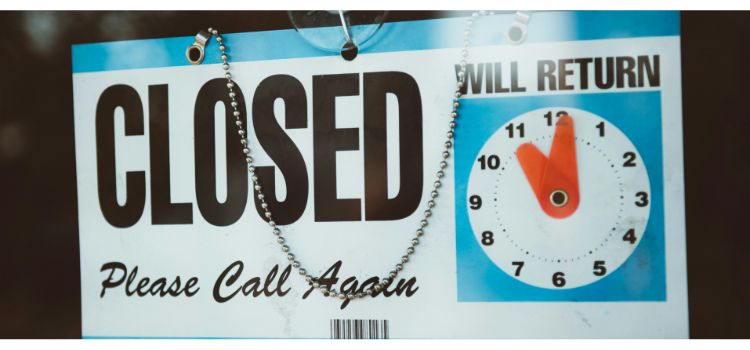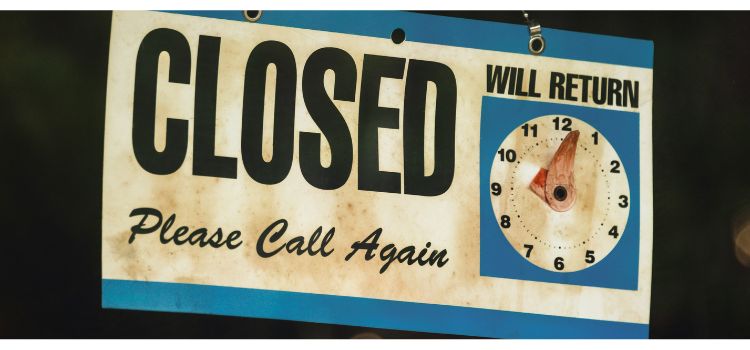As an Amazon Associate, I earn from qualifying purchases

Yes, returning a sign with a clock is a beneficial way to inform customers of your return time. It helps manage their expectations and indicates when to expect your return.
When running a business, it’s essential to communicate with customers effectively. One way to do this is by displaying a sign with a clock to inform them of your return time. This simple yet effective method can help build trust and ensure customers know when to expect your services.
Incorporating this practice can enhance customer satisfaction and create a positive impression of your business. Additionally, it demonstrates professionalism and reliability, essential aspects of a successful operation. Therefore, utilizing a sign with a clock may make a big difference in the client experience and overall business reputation.
History Of Time Measurement
The history of time measurement is a fascinating journey that has evolved through the ages. From the simple observation of the sun’s position to the intricate mechanisms of modern clocks, humans have constantly sought to measure and track time. Understanding the history of time measurement provides valuable insights into the development of civilization and technological advancements.
From Sundials To Clocks
The earliest form of time measurement can be traced back to sundials. These ancient devices relied on the sun’s shadow, which signifies the time of day. Breaking the day into manageable chunks using sundials laid the foundation for precise timekeeping. Various cultures, including water and candle clocks, developed their time measurement methods as civilizations progressed.
Evolution Of The Modern Clock
The mechanical clock was created in the Middle Ages. Ages marked a significant leap in timekeeping technology. These early clocks featured intricate gear systems and were often installed in church towers and public squares. The development of pendulum clocks in the 17th century further refined timekeeping accuracy. As the Industrial Revolution began, mass-produced clocks made accurate timekeeping accessible to the general population.
Symbolism Of Clocks In Signage
The symbolism of clocks in signage goes beyond mere timekeeping; it conveys messages of punctuality, reliability, and tradition.
Time As A Cultural Symbol
Clocks hold cultural significance across different societies, representing the value placed on structure and organization.
Clocks In Public Spaces And Businesses
Visible clocks at establishments and public areas are cues for punctuality and time awareness.
The Concept Of ‘Will Return’ Signs

Origin And Usage
Origin: ‘Will Return’ signs have been a common sight in businesses for decades, originating as a simple yet effective way to inform customers of the owner’s expected return time.
Usage: These signs are typically displayed when a business owner steps out temporarily, indicating when they plan to be back to assist customers. They serve as a communication tool between the business and its patrons.
Impact On Customer Perception
Customer Trust: Seeing a ‘Will Return’ sign conveys transparency and reliability to customers, building trust in the business’s commitment to serving them.
Customer Expectations: The presence of a ‘Will Return’ sign manages customer expectations, reducing frustration and ensuring a positive experience even in the owner’s absence.
Designing A ‘Will Return’ Sign
Designing a ‘Will Return’ Sign is essential for businesses to communicate their operating hours effectively. A well-designed sign informs customers when to expect the company to reopen and serves as a branding opportunity. Incorporating a clock into the ‘Will Return’ sign can enhance its functionality and visual appeal. Balancing aesthetics and functionality is crucial in creating a sign that effectively conveys the necessary information while complementing the business’s overall look.
Incorporating Clocks
Adding a clock to a ‘Will Return’ sign offers a practical solution for conveying the anticipated return time. A prominently displayed clock provides a quick reference point for customers, eliminating the need to estimate the reopening time. By incorporating a clock, businesses can enhance the sign’s functionality and improve the customer experience.
Balancing Aesthetics And Functionality
When designing a ‘Will Return’ sign, it’s important to balance aesthetics and functionality. The sign should align with the business’s branding and visual identity while effectively communicating the return time. Choosing a font and color scheme that complements the overall design and ensures readability is crucial. Additionally, selecting a clock style that complements the sign’s aesthetic can contribute to a cohesive and visually appealing design.
Psychological Effects Of Time Indicators
Waiting Time Perception
How we perceive time while waiting can significantly impact our emotions and behavior. When faced with uncertainty about when something will happen, our minds tend to exaggerate the passage of time, leading to impatience, frustration, and anxiety.
Time Indicators As Trust Builders
Time indicators, such as a sign with a clock displaying the expected return time, can serve as trust-building tools. By clearly indicating when to expect a return, these time indicators create a sense of reliability and dependability, reducing uncertainty and fostering trust in the waiting process.
Digital Transformation
With the advent of Digital Transformation, traditional ‘Will Return’ signs have evolved into sleek, modern solutions that seamlessly integrate with today’s technology.
Electronic ‘Will Return’ Signs.
Electronic ‘Will Return’ signs offer businesses a dynamic and efficient way to communicate their return time to customers.
Interactive And Real-time Updates
These signs provide interactive and real-time updates, ensuring customers are instantly informed of the latest return information.
Case Studies
Exploring the impact of ‘Will Return’ signs with a clock through real-life scenarios provides valuable insights into their effectiveness. Let’s delve into some case studies to understand the outcomes.
Triumphant ‘Will Return’ Signs.
Implementing ‘Will Return’ signs with a clock led to shorter wait times and greater client satisfaction.
When Signs Fail: Lessons Learned
Analyzing instances where ‘Will Return’ signs with a clock did not yield the desired results offers valuable lessons for future implementations.
Future Of ‘Will Return’ Signs

Technological Innovations
In today’s digital age, ‘Will Return’ signs are transforming technological advancements. These signs are becoming more interactive and informative by integrating digital displays and intelligent sensors. Businesses can now utilize electronic ‘Will Return’ signs that display real-time information about when the store will reopen, enhancing customer experience and reducing wait times.
Predicting Consumer Behavior Changes
Given the ongoing changes in customer behavior, the future of ‘Will Return’ signs lies in predicting and adapting to these changes. Companies can now use algorithms for machine learning and advanced analytics to forecast peak hours and adjust their return times accordingly. This proactive approach not only caters to the shifting demands of consumers but also improves operational efficiency.
Frequently Asked Questions
A return sign with a clock is a sign that indicates the expected time of return of a person or object. It is commonly used in businesses, schools, and other institutions to keep track of the whereabouts of their employees or assets.
A return sign with a clock typically has two sides: one that says “in” and one that says “out. ” When a person or object leaves, the sign is flipped to the “out” side, and the time is noted. When the person or object returns, the sign is flipped to the “in” side, and the time is updated.
Using a return sign with a clock can help increase efficiency and organization in a workplace. It can help keep track of employee attendance, prevent theft or loss of company assets, and improve communication among team members.
Return signs with clocks can be purchased at office supply stores, online retailers, or directly from the manufacturer. It is essential to ensure that the sign meets your organization’s specific needs before purchasing.
Conclusion
As we saw, returning a sign with a clock can have various symbolic meanings. Whether it signifies nostalgia, tradition, or a sense of time passing, it adds depth to our surroundings. Embrace the significance and beauty of these timepieces as they enrich our lives with meaning.
As an Amazon Associate, I earn from qualifying purchases
Leave a Reply